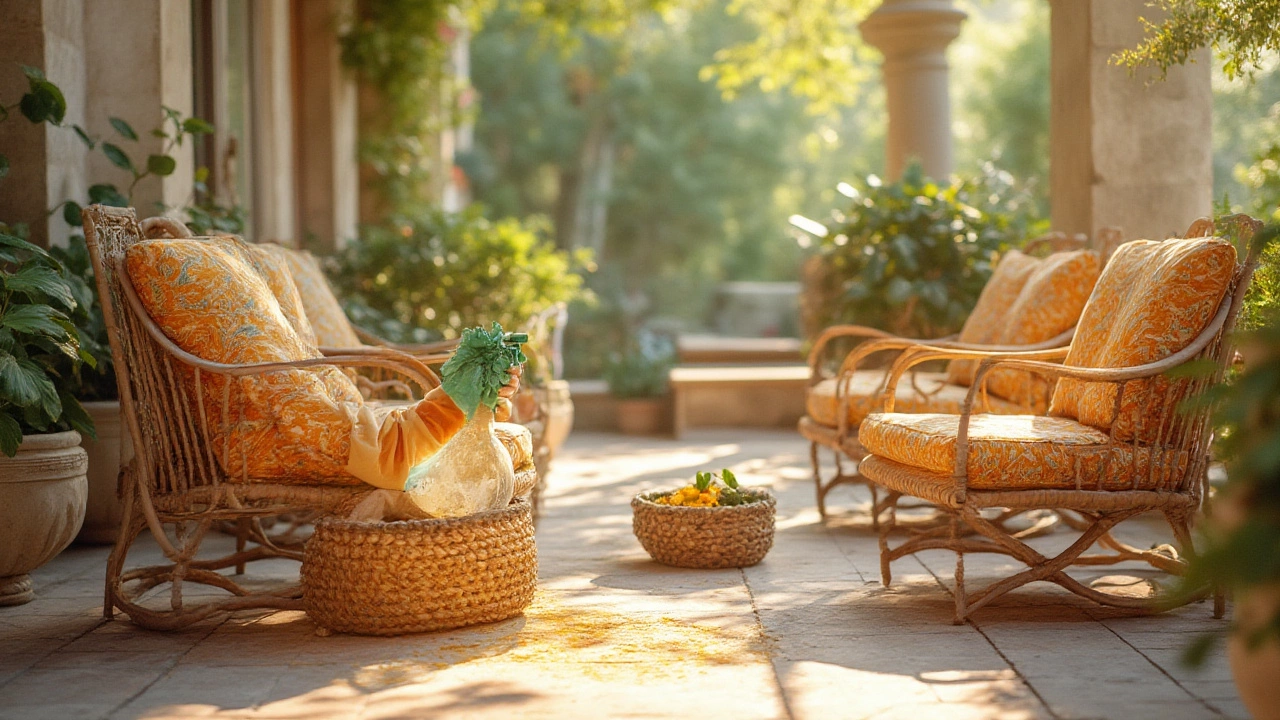It sounds like something out of a horror flick: you finally get a moment to sit out on your patio, only to wind up covered in itchy red welts hours later. That’s the magic trick chiggers pull—silent, invisible, out for blood (well, skin cells). If you’ve ever felt like your patio furniture is cursed, odds are you’re not imagining things. Chiggers, the juvenile stage of harvest mites, actually love the same warm, shady garden nooks you do. And while they don’t fly or jump, they’re expert hitchhikers waiting for their next meal to take a seat. Cross paths with them, and you’ll be scratching for weeks. The good news: you don’t need to lock yourself indoors. You just need some smart tactics to keep these tiny pests off your turf—literally and figuratively.
Understanding Chiggers and Their Sneaky Habits
You’d be right to ask—what is a chigger, anyway? Chiggers, or Trombiculidae larvae, are nearly-microscopic mites that hang out in grass, leaves, and especially shaded damp corners. Adult harvest mites mind their own business. Their larvae, though—those are the itch-inducing terrors. You won’t see them on your patio furniture, but you can’t mistake the aftermath: clusters of red bites that itch for days or even weeks.
Chiggers don’t actually burrow into your skin (a common myth), but they inject digestive enzymes that break down skin cells for a snack, which your immune system reacts to with a vengeance. They thrive in warm, humid spots—exactly the summer conditions that turn backyards into bug buffets. The real trick: chiggers are patient. They sit waiting near the top of tall blades of grass, on leaf piles, or damp corners of outdoor cushions, latching on to the first warm-blooded thing that brushes by. Lawn edges, overgrown garden beds, stacked wood, and neglected outdoor furniture? Prime real estate.
You might not feel their bite at first. Symptoms can show up hours later when you’ve long left the patio behind. Unlike mosquitoes, chiggers usually gather at tight spots: waistbands, sock lines, anywhere elastic presses skin. But your patio cushions, if kept moist and shaded, can serve as perfect breeding grounds, especially if local squirrels, birds, or stray cats nap there. One fun fact: Florida State University’s entomology department found that chiggers thrive most in overgrown, undisturbed vegetation, but even well-manicured yards aren’t immune. All it takes is one stray animal or a humid summer week to bring an infestation. So, staying vigilant is the only way to beat these sneaky pests at their own game.
Unlike ticks or fleas, chigger larvae don’t hang around after feeding. They eat, drop off, and go on their merry way, so you don’t need to worry about them living inside your cushions—just using them as traffic stops. That’s why it’s so frustrating: you can wipe down a chair one day, only to find fresh bites after sitting a few days later. They don’t move fast, but there’s always a steady supply if conditions are right. Spotting chiggers is basically impossible. Even if you could see them, they’re red to orange, tiny as a pinhead, and tuck themselves into folds and fabrics. Long story short: stop waiting to see them. Focus on making your patio as uninviting as possible instead.
Prevention: How to Keep Chiggers Away from Patio Furniture
Let’s be honest—chigger bites are miserable. If you want them out of your life (and I suspect you do), your best bet is prevention. Chiggers don’t like dry, sunny spaces. They hate being exposed. So first step: keep your patio furniture and the surrounding area clean, dry, and sunny.
Here’s the lowdown on prepping your outdoor space to make it chigger-unfriendly:
- Keep grass trimmed short: Chiggers love overgrown, shady lawns. If your patio is surrounded by lush, untamed grass, that’s a welcome mat for mites. Mow regularly, especially the borders.
- Remove leaf litter and debris: Piles of leaves, grass cuttings, wood, or abandoned pots are chigger hotels. Clear them out.
- Move furniture away from natural edges: Don’t leave chairs or benches right up against untrimmed beds or wild patches. A little distance reduces encounters.
- Launder cushions regularly: If your outdoor cushions have removable covers, wash them in hot water every two weeks during chigger season (late spring through early fall).
- Spray down hard surfaces: A quick blast with a high-pressure hose removes not just dirt, but also lingering bugs. Do this after mowing, before parties, or after heavy rain.
- Direct sunlight is your friend: Dry out your patio pads and pillows in the sun. Chiggers dry out and die fast in direct sunlight, so rotate your cushions regularly.
- Keep pets off furniture: Dogs and cats pick up chiggers just like humans. Make a habit of brushing them off after outdoor time and keep their sleeping mats somewhere else.
- Watch where the wildlife goes: Squirrels sunbathing? Birds nesting nearby? Friendly, but they’re also carriers. Keep animal attractants, like bird feeders, away from patio furniture.
- Use natural repellents: Scattering diatomaceous earth under and around your furniture acts as a barrier. It dehydrates and kills chiggers without chemicals—but reapply after each rain.
- Treat furniture covers with permethrin spray: This insect repellent kills chiggers on contact, but always follow label instructions. Never spray directly on surfaces that touch bare skin unless the product is marked safe for fabrics.
If you want an extra layer of insurance, consider treating the whole patio with a safe outdoor pesticide targeted for mites, but always double-check that it’s approved for residential areas. Remember, chiggers aren't like ants or roaches—they don’t live in nests you can attack, so your focus is on making the area bad for loitering larvae. Regular cleaning and sun exposure do most of the heavy lifting.
A small tip from bitter experience: encourage the kids to shake out towels, picnic blankets, and even their shorts before plopping down outside. Finnian learned the hard way—one nap on a forgotten bean bag chair led to three weeks of relentless scratching. It’s a simple ritual, but it can spare a summer of discomfort.

How to Spot and Treat Existing Chigger Infestations
So let’s say prevention slipped, and now someone in the house is covered in red, itchy spots—don’t panic. You’re not dealing with a disaster, but speed helps. First step: confirm it’s actually chiggers. Classic bites tend to show up in clusters, often where clothing is tight against the skin—waistbands, ankles, armpits. The itching can be extreme, especially the first night. A 2017 CDC pest report highlighted that chigger bites are commonly mistaken for poison ivy or mosquito bites, but they’re smaller (about the size of a pencil eraser), surrounded by a bright red halo, and tend to stay itchy for much longer.
If you’re seeing new bites after using your patio, check the usual places. Lift up furniture cushions and look for other signs like spider webs or old insects. Even though you won’t see chiggers themselves, dusty corners or hidden leaf bits can clue you in. Don’t blame the actual furniture first—if you have pets or the lawn is overgrown, track those sources too. Chiggers usually come from the yard, not the chairs.
Once you know you’re dealing with chiggers, it’s time for a deep clean:
- Vacuum or sweep all outdoor furniture thoroughly, lifting and flipping all parts.
- If possible, wash removable fabric covers and let them dry out in full sun.
- Wipe hard surfaces with hot, soapy water. A sponge with dish soap is enough; you don’t need harsh chemicals for most outbreaks.
- For extra measures, you can use a diluted essential oil spray (lemon eucalyptus, peppermint, or clove oil all repel mites), but spot test your furniture first to avoid stains.
- If infestation seems persistent, a pyrethrin-based outdoor spray is usually effective. Spray the ground around furniture, not just the furniture itself.
- If you have pets, treat their fur with pet-safe products to keep them from tracking larvae around. Bathe them regularly in chigger season.
For the humans, wash any exposed skin with soap and water right after sitting outside—research from the Texas A&M AgriLife Extension found this removes most larvae before they start feeding. Already got bites? Don’t scratch (I know, easier said than done). Calamine lotion, hydrocortisone creams, and ice packs all help. Oral antihistamines work too. And yes, bites do stick around up to two weeks, even with treatment. If you notice infection (swelling, pus, fever), visit a doctor—it’s rare, but possible with intense scratching.
A fun trick for prevention post-bite: lightly dust your ankles and waistband with baby powder or cornstarch before going outside. The powder makes it harder for chiggers to latch on and crawl under clothes—old-school, but effective, and way less sticky than most bug sprays.
Long-Term Maintenance: Keeping the Patio Chigger-Free Year Round
Winning the battle is one thing, but you want to avoid a yearly cycle of bites and deep cleans. Here’s how to take chigger-proofing to the next level so your patio stays a refuge, not an itch factory.
- Invest in patio furniture with taut, weather-resistant fabric, or go for metal/wood that doesn’t soak up moisture. Plush, absorbent cushions look nice but hold onto humidity—chigger heaven.
- Use furniture covers during peak season, but lift and air them out every few days so moisture doesn’t build up.
- Apply a chiggers spray treatment before the start of summer, once the weather is consistently warm.
- Switch up your setup—move your chairs and tables every week or so to break the chiggers’ waiting game. They like to settle into habits just like humans.
- Boost airflow with a patio fan if you have an enclosed space. More breeze, less bug activity.
- Add gravel or mulch paths (not grass or soil) underneath and around furniture. Chiggers hate crossing dry, rough ground.
- Plant pest-repellant greenery, like lavender, rosemary, and chrysanthemums, nearby. These naturally repel mites and add some style points to your yard.
- Schedule a thorough cleaning at the start and end of each season—think spring and fall.
- Remember to treat any guest seating or outdoor toys (like bean bags, play tents, or hammocks), since chiggers hop onto anything left outdoors.
Think of chigger-proofing as just another part of patio care—like checking for rust, tightening bolts, or cleaning bird poop off the table. Stay ahead with a mix of cleaning, smart landscaping, and routine spot checks throughout the warm months. If you’re the forgetful type (I blame dad brain), set a monthly reminder on your phone. A little proactive work goes a lot further than reacting to an outbreak.
So next time you kick back on the patio, bring the cold drinks, not the itchy legs. Your future self—and anyone else lounging around—will thank you.
